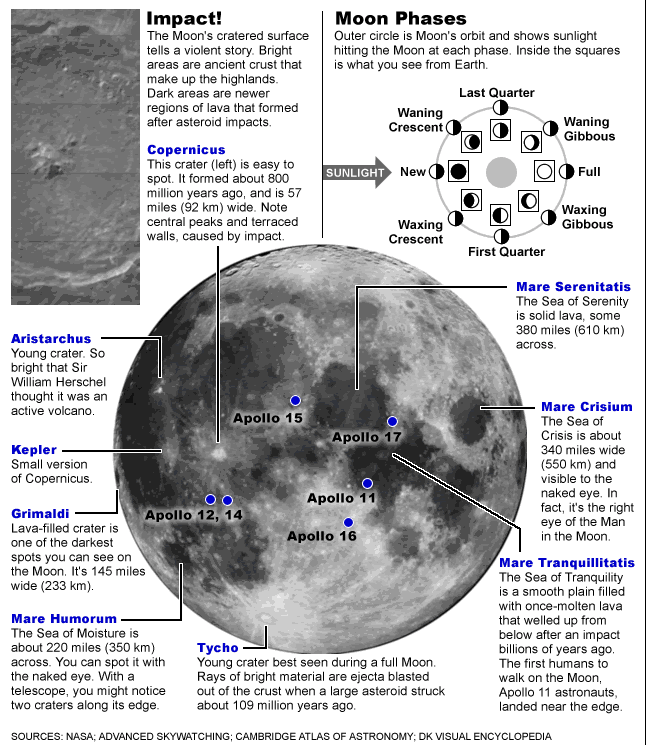The two easiest objects to see in the sky are also the biggest and brightest. They’re also the two that you can see in the daytime, with proper precautions in the case of the Sun.

THE MOON
Because our 3,500 km wide natural satellite is a mere 300,000 km+ or so away (as opposed to the tens of millions or billions of km to the other planets), we see it as fairly large in the sky – A disc about the size of your thumbnail held at arm’s-length (as opposed to a point of light like the planets and stars.)
Fun facts:
- The great lunar crater Copernicus is more than a billion years old
- The dark areas on the Moon called “seas” are ancient lava flows
- Because there’s no weather and almost on atmosphere, the Moon serves as a “museum” of the early days of our Solar System.
- If left undisturbed, footprints of NASA’s Apollo astronauts should remain unchanged on the Moon for at least a million years
Viewing it in the sky:
Seeing the moon in the day or evening sky isn’t too hard, unless you’re looking for a slim crescent before dusk or just after dawn. You can find this and different phases using software like Starry Night, aps like Star Walk, or monthly charts in magazines like Sky News. Meanwhile, here’s a really good basic map of the moon, with seas, major craters, and NASA landing sites labelled.
Just to set the record straight on this: our Sun is a star. And stars are all objects more-or-less like our sun.
Stars are huge (hundreds of thousands to millions of km+ in diameter) balls of mostly hydrogen and helium “burning” for hundreds of millions to billions of years via nuclear reactions. (If a star was just a lump of material combusting like a log in a fire, it would only burn for a few million years at most.)
Depending on the temperature at which they burn, stars can be red, orange, yellow, white, or blue (a red star is least hot, a blue star is super-hot) and range in size from dwarfs about the size of Jupiter to hyper-giants the diameter of Saturn’s orbit around our star.
For comparison, our “star” the Sun is a yellow star about 1 million km in diameter.
Viewing it in the sky:
 First of all NEVER LOOK DIRECTLY INTO THE SUN, ESPECIALLY THROUGH UNFILTERED BINOCULARS OR TELESCOPES.
First of all NEVER LOOK DIRECTLY INTO THE SUN, ESPECIALLY THROUGH UNFILTERED BINOCULARS OR TELESCOPES.
There are several ways you can safely observe the disc of the Sun and details on it such as sunspots (cooler areas of magnetic disturbance that spew out charged particles and help create the Northern Lights on Earth.)
First of all, you can remove the finderscope and keep the lens caps on one side of your binoculars and project the sun onto a piece of paper.
To do this, aim your scope or binoculars by looking at the shadow of your scope or binocs – The Sun should appear for you to focus once the shadow is exactly face-on.
You can also buy a Mylar or glass solar filter for your telescope that fits over the front of your telescope tube or in a hole on the dew/dust cap of larger telescopes.
Finally, you can purchase a specialized telescope for solar observing that will let you see even more details that a Mylar or glass filter won’t, such as the granulation on the Sun’s surface, or giant flaming flares and prominences.
NOTICE/DISCLAIMER: Peter McMahon, Rick Stankiewicz, The Ontario Planetarium, The Peterborough Planetarium, The Jasper Planetarium, Wilderness Astronomy.com, North Star Productions, and any/all subsidiaries take no responsibility for injury as a result of the above steps, followed improperly or properly, and any other attempts to look at the Sun.

